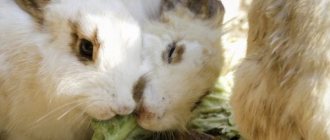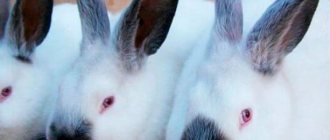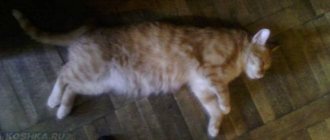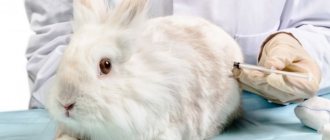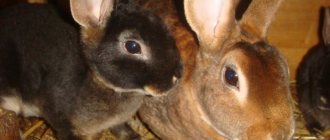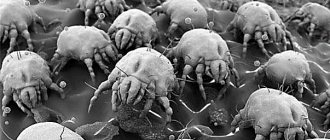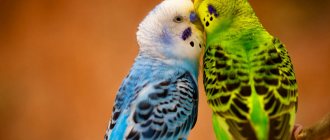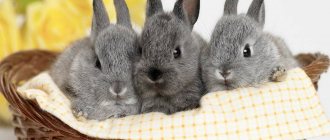Accommodation features: rabbit house
If you decide to get rabbits and create a mini-farm in the village, then at the first stage you need to take care of their place of residence. A ready-made room for a rabbitry is created or used. The animals will be housed more compactly in 2-tier cages. Keeping rabbits indoors is more convenient and rational. Drafts and dampness, prolonged exposure to the sun should be avoided, but ventilation should be provided.
Outdoor home cage option
For a pet, the cage is placed away from heating appliances. If you raise a rabbit in a hot room, the rabbit will experience constant thirst and its health will worsen. It is not recommended to keep him in a cage all the time. In order for the indoor pet to feel good, it is allowed to run around the apartment.
Longer stay for pets - their cage
Keeping an animal’s “house” clean is an important condition for its health. Dirt and urine cause respiratory and eye diseases, so the tray is cleaned three times a week. Once a week, wash thoroughly using disinfectants.
Portable cage option
Feeders, drinking bowls, and hay mangers should be placed in the cage. They need to be well secured so that the animals cannot spill water or contaminate the food. They need to be washed as often as possible.
Animals love to eat indoor flowers. It is necessary to remove poisonous plants from the apartment, install the rest on cabinets or hang them in flower pots.
Is it possible to keep rodents together with chickens? Their cohabitation is possible only if there are no other options. Although they are completely different species, they have common diseases. In addition, the “eared” ones feel uncomfortable in the company of noisy and hectic hens. Therefore, keeping chickens and rabbits together is not recommended.
Feeding rabbits: diet
Caring for a rabbit involves a balanced and thoughtful diet. It is necessary to keep track of what and in what quantities the animals eat. There is a special feed to which they need to be accustomed. Due to the hard granules, the rabbit's teeth are well ground down, the growth of which never stops.
In summer, the best diet for rabbits is fresh grass.
In winter, hay is added to the diet. The feeder should contain solid food: carrots or other root vegetables, hard branches of fruit trees. Prepare mash with boiled vegetables or potatoes with the addition of bran. Small amounts of salt, bone meal and chalk should be present in the diet. Feeding occurs twice a day, with a 12-hour break between them.
When breeding rabbits, proper feeding is very important.
An important condition is to constantly add water to the drinking bowls. Without water, feed is not fully digested. If the food is dry, then the “eared” one needs 0.5 liters per day. water. In summer there is no such need for water, since the feed is succulent.
How does a baby rabbit develop?
First of all, it’s worth talking about weight gain or growth dynamics. At birth, a baby rabbit can weigh 50-70 g, it all depends on the breed characteristics. Female milk has a fat content of 16 to 22%, it is high in calories, and therefore, by 10 days from the moment of birth, the young animals significantly gain weight. If feeding is sufficient, then by the age of 30 days the rabbits can have the following weight indicators, depending on the breed:
| Breed name | Weight in kg |
| Giants white and gray | 0,7 |
| Soviet chinchillas | 0,5 |
| Vienna silver and blue | 0,45 |
| White down | 0,4 |
White giant
Good to know. The growth of rabbits continues until 8-10 months; weight gain is completed at this age.
Basic care requirements
A rabbit is a mobile animal that needs activity. For walks, he is wearing a harness (collar with leash). In order not to scare the animal, the harness must be put on carefully and slowly. The harness is not tightened, but fastened, otherwise the rabbit may strangle itself out of fear.
Before purchasing a pet, carefully study the question of how to properly care for rabbits. There are many important care techniques, without which the animal will feel uncomfortable.
Nail trimming
When kept in grazing conditions, the claws grind down on their own, but in apartment conditions this is impossible. The cutting technique is simple; the claws can be cut with clippers. The procedure is carried out regularly: the claws are cut once a month. Trimmed claws are carefully filed. Trim them carefully as they contain capillaries.
Vaccination
Furry pets are susceptible to various diseases, so vaccination is very important. Vaccines are administered at one and a half months of life, when the baby rabbit weighs 0.5 kg. It is necessary to vaccinate rabbits during this period.
Fur care
The animal's fur needs daily care (even during molting) so that tangles do not form in the fur. Hair mats quickly, so use a comb or slicker for cats or dogs. Wool often gets into the animal's stomach, clogging the intestines. This is the most dangerous disease that can be prevented by caring for your fur.
Bathing a rabbit
Is it possible to bathe rabbits? A furry pet does not need this procedure when it is at home. Yes, and washing it is not so easy. If the rabbit is very dirty, then bathing is necessary. The process of taming to this procedure is impossible. If the contamination is partial, then wipe the dirty area with a damp cloth.
Grinding down teeth
An animal's teeth grow throughout its life, and caring for a rabbit at home involves regularly grinding them down. Teeth are ground down using:
- Special feed;
- Hard vegetables;
- Branches of fruit trees;
- Special sticks with vitamins and cereals, toys.
Castration
Castrating a rabbit at home involves removing the male reproductive organs. Sterilization is a necessary procedure that helps:
- Increase their growth by 20% without additional costs for feed;
- Keep males in one cage;
- Indoor rabbits stop breeding;
- Increase their lifespan.
Castration of rabbits promotes their calmer behavior: they are not aggressive and do not bite. They are neutered between the ages of 4 months and 2 years.
Taming the litter tray, litter trays
The big-eared dog quickly gets used to the special toilet installed in the cage. When he starts going to the litter box in a crate regularly, you can try toilet training him in one place in the house.
Rabbit tray
You can recognize why an indoor animal refuses to go to a place adapted for it for a number of reasons:
- The tray is not large enough or is inconvenient;
- Filler that is unpleasant for animals;
- Inappropriate location chosen for the toilet.
Teaching a rabbit to “visit one place” is quite possible. An adult castrated rabbit is easier to tame than a three-month-old baby rabbit. Gradually he will recognize his litter box.
Rabbits feel more comfortable with artificial filling
Artificial fillers create more comfortable conditions for animals and make them easier to care for, which eliminates the question of how to accustom a rabbit to a litter tray. Fillers are:
- Wood from compressed granules;
- Mineral;
- Silica gel
- Japanese.
The highest quality, safest and most expensive are silica gel fillers, which are changed once every 30 days. The choice is up to the owner.
Early exit of baby rabbits from the nest
The cubs leave the nest early, either forcibly or of their own free will. In any case, this means a failure in the normal system of development and care for offspring.
Having gained sight and become covered with fur, the babies do not have to wait for their own fate, but try to leave the queen cell on their own. The most common reasons for this behavior:
- lack of nutrition - slow lactation of the rabbit, lack of milk gives an impulse to look for additional food;
- crowding - too many newborns make staying in the nest uncomfortable, especially when the period of active growth begins;
- external conditions - insufficient ventilation of the queen cell, elevated temperatures create an unfavorable microclimate and force them to look for more comfortable conditions outside the nest.
The female can throw away the rabbits if she feels that she cannot fully feed the offspring.
Hand Taming
To understand how to accustom a rabbit to your hands, you need to watch it. At first he will be shy, so you need to talk to him so that he gets used to the environment and the new owner.
Rabbits at home
Since this is a burrowing animal, being raised above the ground is a shock for it. Do not lift the animal by the ears. This is very painful for him and can damage the ear membranes and muscles. This must be done very carefully so as not to cause fear:
- Stroke the animal's fur - from head to tail
- Take it under the body, supporting it from below
- Do not lift it high, keep it at the same level with you.
If you behave correctly and carefully handle the animal, then the question of how to tame a rabbit will disappear by itself.
Rabbits are animals with a developed nervous system. Loud sounds, noise, flashes of light, and unexpected changes in daily routine become stressful for him. Try to protect him from this and do not touch him when he eats, washes or sleeps.
Special toys have been created for those with big ears. Small rubber balls, soft toys, and old books will do. They develop the rabbits physically, and they don't damage household items as much. How to stop a rabbit from chewing wires: give him a toy.
Why does a rabbit bite?
The animal's aggression manifests itself in the form of grumbling, throwing and biting. They bite most often out of fear. A female with cubs may also bite to protect her offspring. Food and territory are also a matter of protection, so the reasons may vary. In order to wean a rabbit from biting you need to:
- Try to change his diet;
- Castrate;
- Treat him with care and precision to rid him of fear.
It is important for a pet to know that he and his offspring are safe, then he will stop behaving aggressively. A physiological factor such as sleep is also important.
Sometimes it seems that animals do not sleep at all. But most often they do not sleep at night, and during the day they look awake, but in fact their eyes are slightly closed and they almost do not react to sounds: this is how rabbits sleep.
Lifespan and sex determination
On average, furry rodents live from 5 to 10 years. It all depends on the care and maintenance, on the attitude towards the animal. Large females become sexually mature at 5-8 months, and decorative ones at 4-6 months. The reproductive instinct is pronounced, pregnancy lasts about a month. In the litter of large breeds there is a maximum of 12 cubs, in decorative breeds - up to 5 individuals.
Giant White Rabbit Family
After giving birth, small and helpless rabbits are born. Newborn babies are born naked, their eyes open after 2 weeks. They begin to eat independently 15-17 days after birth. In the first days of life and during the growth period of the rabbits, the female rabbit needs to be fed well, and try to make her diet more varied. Baby rabbits need to be cared for with care and caution. Babies must be with their mother for up to 3 months, after which they are prepared for sale. So the female takes care of the rabbits for up to 3 months.
The sex of baby rabbits can be determined closer to 3 months of their life.
Until the age of three months, no one will answer the question of how to find out the gender of a rabbit, since during this period it is impossible to find out the gender. In older animals, males can be distinguished from females only by their reproductive organs. The sex of a rabbit is determined by carefully examining the reproductive systems of the rabbit and the female rabbit. This is the only method by which one can tell whether a boy or a girl has been born.
How to determine the age of a rabbit?
It is impossible to determine exactly how many years animals live by external signs. But there are a number of techniques that allow you to do this:
- Palpation of the ribs, which can be easily felt. Up to 6 months, the ribs are soft;
- Teeth enamel color. The yellower the teeth, the older the rabbit;
- In an adult “eared” eyelids sag, swell, and become uneven;
- The length of the claws, even if they are cut, these places are clearly visible. In older individuals they bend.
Experienced rabbit breeders can determine the approximate age of an animal based on these characteristics. It is impossible to do this by size, since the size depends on the breed and a number of other factors.
Refusal to feed
Reluctance to feed born offspring may have various reasons. Among them:
- Mastitis. Painful sensations associated with inflammation of the mammary glands and hardened nipples can completely discourage a rabbit from breastfeeding.
When a disease occurs, the animal needs timely assistance, which guarantees a return to a normal rhythm of life. It is better to confirm suspicions of mastitis with a diagnosis from a specialist who will prescribe the necessary procedures. If mastitis is diagnosed, children should not bother their mother; this must be monitored. Pain when trying to latch on gets worse and becomes the cause of aggression towards the offspring. Schematic representation of mastitis - Hormonal disbalance. Too active behavior of the female the very next day after giving birth indicates a desire to mate.
She moves dynamically, chews hay and tears the fluff on her chest. In this state, the animal is dangerous for its offspring; it should be placed in a cage with a male. Usually, after mating, the female calms down and is ready to continue performing maternal duties. A female rabbit needs mating if she actively chews hay the day after giving birth. - External stimuli. Too loud sounds, bright lights, or excessive interest from strangers in the offspring can frighten a young mother and cause a lack of milk. To prevent such a situation, the rabbit needs complete rest before and after giving birth.
- Lack of maternal instinct. The phenomenon can be recognized in advance by the behavior of the rabbit before giving birth. Females with weak maternal instincts usually show no desire to build a nest for their offspring. By observing the female rabbit, you can predict the possible abandonment of the cubs and prevent aggressive actions. At best, such a female will simply not pay attention to the newborns; at worst, she will try to bite them to death.
A female rabbit may ignore newborns without showing maternal care.
